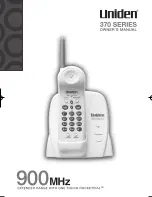
10
SAR: Tests for SAR are conducted using standard operating positions specified
by the FCC with the UPCS handset transmitting at its highest certified power
level in all tested frequency bands. Although the SAR is determined at the highest
certified power level, the actual SAR level of the UPCS handset while operation
can be well below the maximum value. In general, the closer you are to a
wireless base station antenna, the lower the power output. Before a Handset
model is available for sale to the public, it must be tested and certified to the
FCC that it does not exceed the limit established by the government-adopted
requirement for safe exposure. The tests are performed in positions and locations
at the ear as required by the FCC for each model. While there may be differences
between the SAR levels of various UPCS handsets and at various positions,
they all meet the government requirement for safe exposure.
Health and Safety Information FCC: Exposure to Radio Frequency (RF) Signals.
Your wireless handset is a radio transmitter and receiver. It is designed and
manufactured not to exceed the emission limits for exposure to radio frequency
(RF) energy set by the Federal Communications Commission of the U.S.
Government. These limits are part of comprehensive guidelines and establish
permitted levels of RF energy for the general population. The guidelines are
based on the safety standards previously set by both U.S. and international
standards bodies: This EUT has been shown to be capable of compliance for
localized specific absorption rate > (SAR) for uncontrolled environment/general
population exposure limits specified in ANSI/IEEE> Std. C95.1-1992 and had
been tested in accordance with the measurement procedures specified in
FCC/OET Bulletin 65 Supplement C (2001) and IEEE Std. 1528-2003 December
2003).The standards include a substantial safety margin designed to assure the
safety of all persons, regardless of age and health. The exposure standard for
wireless UPCS handset employs a unit of measurement known as the Specific
Absorption Rate, or SAR. The SAR limit set by the FCC and IC Canada is
1.6W/kg *. * In the U.S. and Canada, the SAR limit for mobile phones used by
INDUSTRY OF CANADA REQUIREMENTS
NOTICE: The Industry Canada label identifies certified equipment. This certification
means that the equipment meets certain telecommunications network protective
operational and safety requirements as prescribed in the appropriate Terminal
Equipment Technical Requirements documents. The department does not guarantee
the equipment will operate to the users satisfaction. Before installing this
equipment, users should ensure that it is permissible to be connected to the
facilities of the local telecommunications company. The equipment must also be
installed using an acceptable method of connection. The customer should be
aware that compliance with the above conditions may not prevent degradation of
service in some situations. Repairs to certified equipment should be coordinated by
a representative designated by the supplier. Any repairs or alterations made by the
user to this equipment, or equipment malfunctions, may give the telecommunications
company cause to request the user to disconnect the equipment. Users
should ensure for their own protection that the electrical ground connections of
the power utility, telephone lines, and internal metallic water pipe systems, if
present, are connected together. This precaution may be particularly important in
rural areas.
Caution: Users should not attempt to make such connections themselves, but should
contact the appropriate electric inspection authority or electrician, as appropriate.
The Ringer Equivalence Number (REN) of this device is 1.3B.
Notice: The Ringer Equivalence Number (REN) assigned to each terminal device
provides an indication of the maximum number of terminals allowed to be connected
to a telephone interface. The termination on an interface may consist of any
combination of devices subject only to the requirement that the sum of the Ringer
Equivalence Numbers of all the devices does not exceed 5. This telephone connects
to the telephone network under the connecting arrangement code
CA11A.
IMPORTANT SAFETY INSTRUCTIONS
WHEN USING YOUR TELEPHONE EQUIPMENT, BASIC SAFETY PRECAUTIONS SHOULD
ALWAYS BE FOLLOWED TO REDUCE THE RISK OF FIRE, ELECTRIC SHOCK AND INJURY
TO PERSONS, INCLUDING THE FOLLOWING:
1. READ AND UNDERSTAND ALL INSTRUCTIONS.
2. FOLLOW ALL WARNINGS AND INSTRUCTIONS MARKED ON THE PRODUCT.
3. UNPLUG THE PRODUCT FROM THE WALL OUTLET BEFORE CLEANING. DO NOT
USE LIQUID CLEANER OR AEROSOL CLEANERS. USE A DAMP CLOTH FOR CLEANING.
4. DO NOT USE THIS PRODUCT NEAR WATER, FOR EXAMPLE, NEAR A BATHTUB,
WASH BOWL, KITCHEN SINK OR LAUNDRY TUB, IN A WET BASEMENT, OR NEAR A
SWIMMING POOL.
5. DO NOT PLACE THIS PRODUCT ON AN UNSTABLE CART, STAND OR TABLE. THE
PRODUCT MAY FALL, CAUSING SERIOUS DAMAGE TO THE PRODUCT.
6. SLOTS AND OPENINGS IN THE CABINET AND THE BACK OF BOTTOM ARE PROVIDED
FOR VENTILATION, TO PROTECT IT FROM OVERHEATING. THESE OPENINGS
MUST NOT BE BLOCKED OR COVERED. THE OPENINGS SHOULD NEVER BE
BLOCKED BY PLACING THE PRODUCT ON THE BED, SOFA, RUG OR ANY OTHER
SIMILAR SURFACE. THIS PRODUCT SHOULD NEVER BE PLACED NEAR OR OVER A
RADIATOR OR HEAT REGISTER. THIS PRODUCT SHOULD NOT BE PLACED IN A
BUILT-IN INSTALLATION UNLESS PROPER VENTILATION IS PROVIDED.
7. NEVER PUSH OBJECTS OF ANY KIND INTO THIS PRODUCT THROUGH CABINET





























